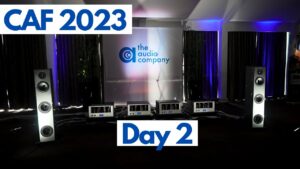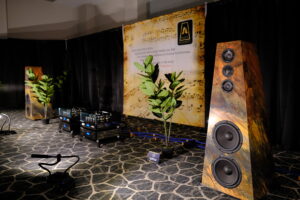
The annual Denver high-end audio festival is now history, although, to be honest, it wasn’t really memorable history. In most respects, this was not a great-sounding show. Nor did it seem to me to be as well-attended as it has been in the past. There were a lot more exhibitors and fewer civilians; of course, the exhibitors had committed long before the stock market collapsed, and the civilians…well, five and six-figure stereos may not hold quite the same appeal as they did a year ago (or a month ago, or a week ago). If you’re in this industry, in the immortal words of Bette Davis, “Buckle your seatbelts. It’s gonna be a bumpy flight!” The sound at RMAF might not have been as across-the-board spectacular as I’d hoped for, but there were enough high points to keep the show interesting and there were some real surprises (at least for me). As usual I apologize in advance to anyone whose room I missed; it wasn’t for want of trying, believe me, but when you’ve got a mere three guys trying to cover a hundred-and-sixty or so rooms (and to do them descriptive justice), you’re inevitably gonna fall short. I’m going to divide this report into four sections (though some products fall into more than one): 1) surprises (manufacturers or products which hadn’t showed well in the past that did an about-face or products that, well, just surprised me); 2) introductions (new products that were launched or made their U.S. debuts at RMAF); 3) disappointments (products that didn’t show as well as they had in the past or, simply, didn’t show particularly well); and 4) triumphs (flat-out winners). Today, I’m going to cover the “surprises.” I’ll do the other three sections as time permits over the coming week. Remember when you read this that I’m just one guy with a pair of ears and a briefcase full of blues, folk, and classical. Shows are notoriously unfair to exhibitors (this year particularly, I thought), and where it was obvious I will comment on how poor room acoustics affected the sound. OTOH, everyone has a more or less equal chance at glory, and the fact that some exhibitors achieve it (and do so consistently) means something.
Surprises
In Room 522, YG Acoustics showed its $38k Kipod Studio, a floorstander with a two-way head unit perched atop a separate powered woofer. To be honest I’ve never liked the sound of YG Acoustics Anat Reference: It’s been very detailed all right, but it’s also seemed very analytical–the kind of speaker designed by an engineer rather than a music lover. On top of this, the Anat’s head units have meshed poorly with its woofer units. So imagine my surprise when the Kipod turned out to be wonderful! Very open, very dynamic (with terrific scale and range), very lively, with extraordinarily deep, fast, detailed, and well-integrated bass. Of all the speakers I heard at RMAF, this one (and the speaker that follows it on this list) was the biggest surprise–and certainly one of the best sounds at RMAF.
In Evergreen A, I came upon Classic Audio Reproductions‘ $38k T-1.2 three-way horn loudspeakers. I’ve heard various versions of Classic horn-loaded loudspeakers (inevitably powered by Ralph Karsten’s Atma-Sphere electronics) for the better part of a decade, and while their sound has steadily improved I wasn’t prepared for the leap the T-1.2 has made. Using field-coil drivers designed by the redoubtable Dr. Bruce Edgar, these speakers are so greatly improved in focus, neutrality, resolution, and extension (and so much lower in amorphousness, “cupped-hands” coloration, and confusion) that I almost didn’t recognize them as horns. A terrific accomplishment.
In Room 551, Alfie Lew of Gini Systems was showing the $15k Von Schweikert Unifield 3 a three-way in two pieces (with a Fostex midrange and Raven ribbon tweeter in the head unit and a SEAS magnesium woofer in the bass cabinet). Like YG’s three-way, the Unifield sounded simply terrific–open, neutral, lively, and very dynamic. If I were Albert I would always show with Audio Space amplification and preamplification. This is the second fest in a row where the combination of Peter Lau’s superb electronics ( the $3390 Reference 3 integrated amp, this time) and Von S’s speakers wowed me (which hasn’t been the case with Von S’s in the past). Certainly one of the best sounds at RMAF–and quite a good value compared to the competition.
In the Blanca Peak room, Hansen introduced a three-way, “nearfield” version of The King, called The Emperor. Although I expected this royal not to have clothes, to my utter surprise The Emperor sounded excellent on two cuts I know very well. Natural, detailed, airy, present, with good bass (which, I think, was getting a little boost from the room–enough to make it sound chunky but not fat), Hansen’s Emperor was far and away the best speaker I’ve heard from this manufacturer.
Speaking of the best I’ve heard from a manufacturer…I’ve certainly had my problems with Scaena12-12 ribbon/cone line-array loudspeakers at past shows, where they’ve sounded grossly colored and incoherent. At first, I thought the Ghost of CES Past was paying me a visit again, when I went to the Scaena room at the Hyatt and heard Guitar Gabriel singing and playing “Keys to the Highway”–a cut I know by heart and have played back on almost every stereo system I’ve listened to at shows over the past 10 years (and, of course, at home). The sound was downright weird–no focus, no positioning, no coherence, with gross coloration of the timbre and textures of Gabriel’s guitar (and all those E-flats he plays). What made this doubly weird was that Scaena was using a dCS Scarlatti as the source–the best-sounding CD player I’ve ever heard (and apparently I’m not alone because there were more dCS Scarlattis at RMAF than any other source of any kind). BUT…turns out the guy running the room was also using the dCS Purcell upconverter, which turns the DSD stream into 176 PCM. I asked him to switch over to DSD and, violin and viola, everything changed! The swimminess disappeared, the overripe timbres became natural (and recognizable), everything firmed up, and the record sounded, as it always does, great. No, the presentation wasn’t quite as detailed as I’ve heard from some of the very best, and on a Dean Martin cut the stage was not quite as wide as I’m used to, but honestly compared to what Scaenas have sounded like in the past this was a revolution–and darn good by any standard. [After I wrote this report, I was told by proud new father David Steven of dCS that the clock and other parameters of the Scarlatti transport/DAC/clock and Purcell system in the Scaena room were improperly set by the folks at Scaena, so the grossly distorted sound I heard on first listen through the Purcell may well have been more that the unhappy effects of downconversion. Rav of dCS later tore down the system and put everything in good order. JV]
In Long’s Peak, On A Higher Note was demo’ing the $15k Vivid Audio B-1, a fashion-plate of a three-and-a-half-way that sounded extremely open and airy, albeit a little swimmy and defocused. Turns out that the most surprising thing in the room was on the walls, in the form of Synergistic Research’s ART (Acoustic Room Treatment). System pictured below.
I don’t know what these little Christmas tree ornaments were doing (they were on all four walls), but, lawsy, they sure were doing something to the soundstage! With them in, the stage bulged as if you were listening to omnis. Without them…well, the Vivids still sounded great and considerably more focused, but, boy, that soundstage sure did deflate. A fascinating device, and with it or without it the Vivid B-1s sounded considerably better than the larger candy-kiss Vivids sounded at CES.
In Room 581, I stumbled upon this Italian two-way, the $11.6k Gemme Audio Katana (the speaker on the far right–the tallest of the three pictured here). What made the Katana (which could just as easily be listed under “introductions,” as I’d never heard it before) surprising was its woofer. Looks like a typical floorstanding two-way with ceramic drivers, doesn’t it? Well, it isn’t. If I heard right, the Katana uses a folded horn in the bass, hidden inside that piano-black enclosure! Not only that but the Katana is a crossover-less design (the mid/bass is allowed to roll off on its own)! You sure couldn’t hear any kind of horn coloration from where I sat. In fact, the thing sounded extraordinarily quick and natural and very highly detailed from top to bottom. This is a speaker that TAS ought to review and one of the better sounds at RMAF.

By Jonathan Valin
I’ve been a creative writer for most of life. Throughout the 80s and 90s, I wrote eleven novels and many stories—some of which were nominated for (and won) prizes, one of which was made into a not-very-good movie by Paramount, and all of which are still available hardbound and via download on Amazon. At the same time I taught creative writing at a couple of universities and worked brief stints in Hollywood. It looked as if teaching and writing more novels, stories, reviews, and scripts was going to be my life. Then HP called me up out of the blue, and everything changed. I’ve told this story several times, but it’s worth repeating because the second half of my life hinged on it. I’d been an audiophile since I was in my mid-teens, and did all the things a young audiophile did back then, buying what I could afford (mainly on the used market), hanging with audiophile friends almost exclusively, and poring over J. Gordon Holt’s Stereophile and Harry Pearson’s Absolute Sound. Come the early 90s, I took a year and a half off from writing my next novel and, music lover that I was, researched and wrote a book (now out of print) about my favorite classical records on the RCA label. Somehow Harry found out about that book (The RCA Bible), got my phone number (which was unlisted, so to this day I don’t know how he unearthed it), and called. Since I’d been reading him since I was a kid, I was shocked. “I feel like I’m talking to God,” I told him. “No,” said he, in that deep rumbling voice of his, “God is talking to you.” I laughed, of course. But in a way it worked out to be true, since from almost that moment forward I’ve devoted my life to writing about audio and music—first for Harry at TAS, then for Fi (the magazine I founded alongside Wayne Garcia), and in the new millennium at TAS again, when HP hired me back after Fi folded. It’s been an odd and, for the most part, serendipitous career, in which things have simply come my way, like Harry’s phone call, without me planning for them. For better and worse I’ve just gone with them on instinct and my talent to spin words, which is as close to being musical as I come.
More articles from this editorRead Next From Show
See all
Best of Show: Southwest Audio Fest 2024
- Mar 18, 2024

Capital Audio Fest 2023 | Day 2 Show Report
- Nov 17, 2023




















